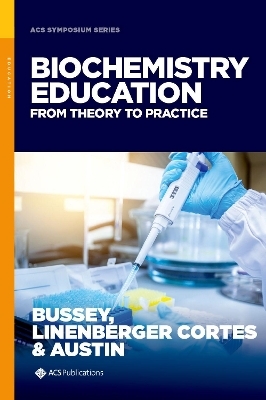
Biochemistry Education
Oxford University Press Inc (Verlag)
978-0-8412-3633-2 (ISBN)
This volume brings together resources from the networks and communities that contribute to biochemistry education. Projects, authors, and practitioners from the American Chemical Society (ACS), American Society of Biochemistry and Molecular Biology (ASBMB), and the Society for the Advancement of Biology Education Research (SABER) are included to facilitate cross-talk among these communities. Authors offer diverse perspectives on pedagogy, and chapters focus on topics
such as the development of visual literacy, pedagogies and practices, and implementation.
Thomas J. Bussey a biochemist and chemical education researcher. His research focuses on students' visual literacy of abstract and emergent science depicted by external representations-e.g., pictures, animations, and simulations-and measured through qualitative analysis of students' perceptions and quantitative analysis of students visual behaviors. Dynamic biochemical systems constitute a unique focus in his work. Thom earned a B.S. with honors in biochemistry and music from the University of Wisconsin-Madison, a M.Ed. in secondary science with an emphasis in technology and his Ph.D. in chemistry with a research focus in chemical education from the University of Nevada, Las Vegas. He is currently an assistant teaching professor in the Department of Chemistry and Biochemistry at the University of California, San Diego where he teaches courses in biochemistry, general chemistry, and science education. Kimberly Linenberger Cortes is a biochemistry education investigating how to best teach and learn biochemistry for the last 12 years publishing multiple articles and presenting her work at numerous conferences. Her work has been funded by the National Science Foundation. Cortes earned a B.S.Ed. in chemistry from the University of Central Missouri and a Ph.D. in chemistry (chemistry education) from Miami University. She is currently Associate Professor of Chemistry Education at Kennesaw State University. There, Cortes currently teaches general chemistry and a one semester biochemistry survey course. She also works with biology and chemistry educators across secondary and post-secondary degree programs to integrate biological and chemical concepts in their instruction. Also, he has given presentations about implementing active learning instruction at BCCE and the Ohio Project Kaleidoscope conferences. Rodney received a B.S. in chemistry at Mount Vernon Nazarene University and a Ph.D. in chemistry (biochemistry) from the University of Cincinnati. He is currently Associate Professor of Chemistry at Geneva College. There he teaches courses in chemistry, including an interdisciplinary travel course focused on water issues. Rodney C. Austin started using the Process Oriented Guided Inquiry (POGIL) approach to teaching chemistry and biochemistry in 2009. He has worked with biochemistry faculty from across the country in developing POGIL curricula, including contributions to the POGIL book, Foundations of Biochemistry. Austin has co-organized symposia related to biochemistry lecture instruction at three Biennial Conference on Chemistry Education (BCCE) meetings.
Preface
Visual Literacy
Chapter 1. Quantifying the Types of Representations Used in Common Biochemistry Textbooks, Kimberly Linenberger Cortes, Chloe House, Rhodelle Lewis, Shreya Krishnan, Kimberly Kammerdiener, Morgan Tamayo, and Thomas J. Bussey
Chapter 2. Virtual Exploration of Biomolecular Structure and Function, Shuchismita Dutta and Daniel R. Dries
Chapter 3. Physical Models Support Active Learning as Effective Thinking Tools, Cassidy R. Terrell, Margaret A. Franzen, Timothy Herman, Sunil Malapati, Dina L. Newman, and L. Kate Wright
Pedagogies and Practices
Chapter 4. Skills and Foundational Concepts for Biochemistry Students, Ellis Bell, Joseph Provost, and Jessica K. Bell
Chapter 5. Implementing Guided Inquiry in Biochemistry: Challenges and Opportunities, Jennifer Loertscher and Vicky Minderhout
Chapter 6. The Development and Use of Case Studies, Sarah Baas Robinson, Erin Dolan, Kathleen Cornely, Amy E.Medlock, Jin Kyu Lee, and Paula P. Lemons
Chapter 7. Development and Use of CUREs in Biochemistry, Joseph J. Provost, Jessica K. Bell, and John E. Bell
Chapter 8. Lab eNotebooks, Keri Colabroy and Jessica K. Bell
Chapter 9. Formative Assessment to Improve Student Learning in Biochemistry, Erika G. Offerdahl and Jessie B. Arneson
Chapter 10. Best Practices in Summative Assessment, Heather L. Tienson-Tseng
Implementation
Chapter 11. Don't Go It Alone: The Importance of Community and Research in Implementing and Maintaining Innovative Pedagogy, Rodney C. Austin and Tracey Arnold Murray
Chapter 12. Vignette #1: Introducing Active Learning to Improve Student Performance on Threshold Concepts in Biochemistry, Mary A. Kopecki-Fjetland
Chapter 13. Vignette #2: Making a Switch to In-Class Activities in the Biochemistry Classroom, Emily J. Ragan
Chapter 14. Vignette #3: Developing Student Proficiency in Reading Biochemical Literature, Rhonda J. Scott
Chapter 15. Vignette #4: Implementation of POGIL-Inspired Experiments in the Biochemistry Laboratory, Kyle R. Willian
Chapter 15. Vignette #5: Incorporating Topic-Focused, Student-Derived Projects in the Biochemistry Laboratory Curriculum, DeeAnne M. Goodenough-Lashua
Editors' Biographies
Author Index
Subject Index
| Erscheinungsdatum | 24.03.2020 |
|---|---|
| Reihe/Serie | ACS Symposium Series |
| Verlagsort | New York |
| Sprache | englisch |
| Maße | 185 x 262 mm |
| Gewicht | 982 g |
| Themenwelt | Naturwissenschaften ► Biologie ► Biochemie |
| Naturwissenschaften ► Chemie ► Physikalische Chemie | |
| ISBN-10 | 0-8412-3633-X / 084123633X |
| ISBN-13 | 978-0-8412-3633-2 / 9780841236332 |
| Zustand | Neuware |
| Haben Sie eine Frage zum Produkt? |
aus dem Bereich


